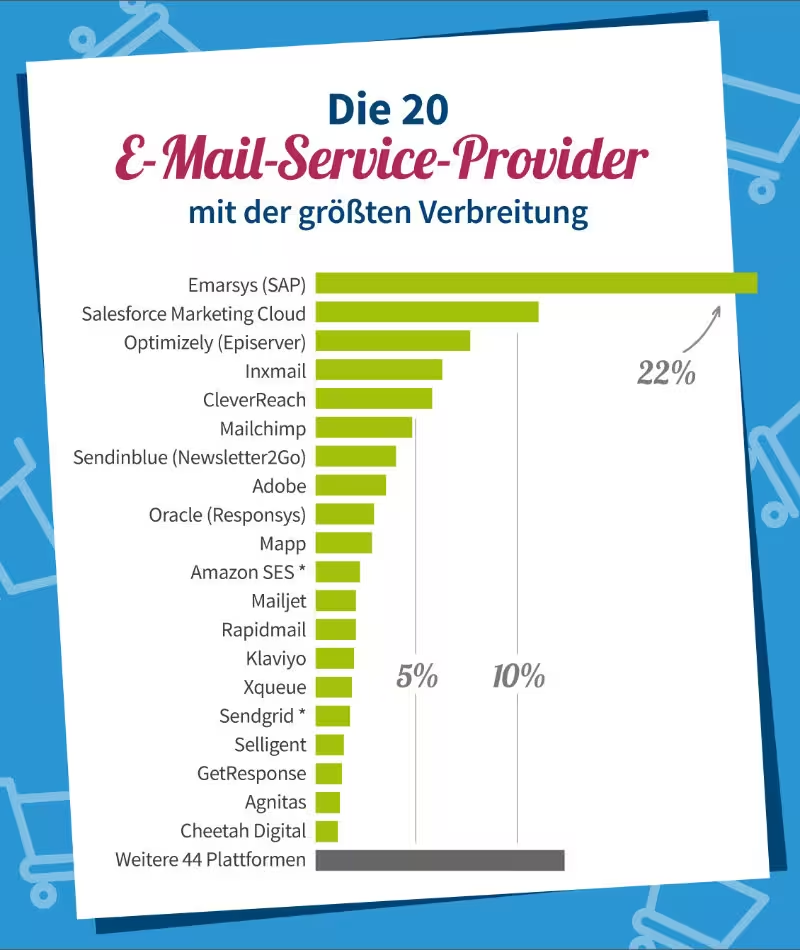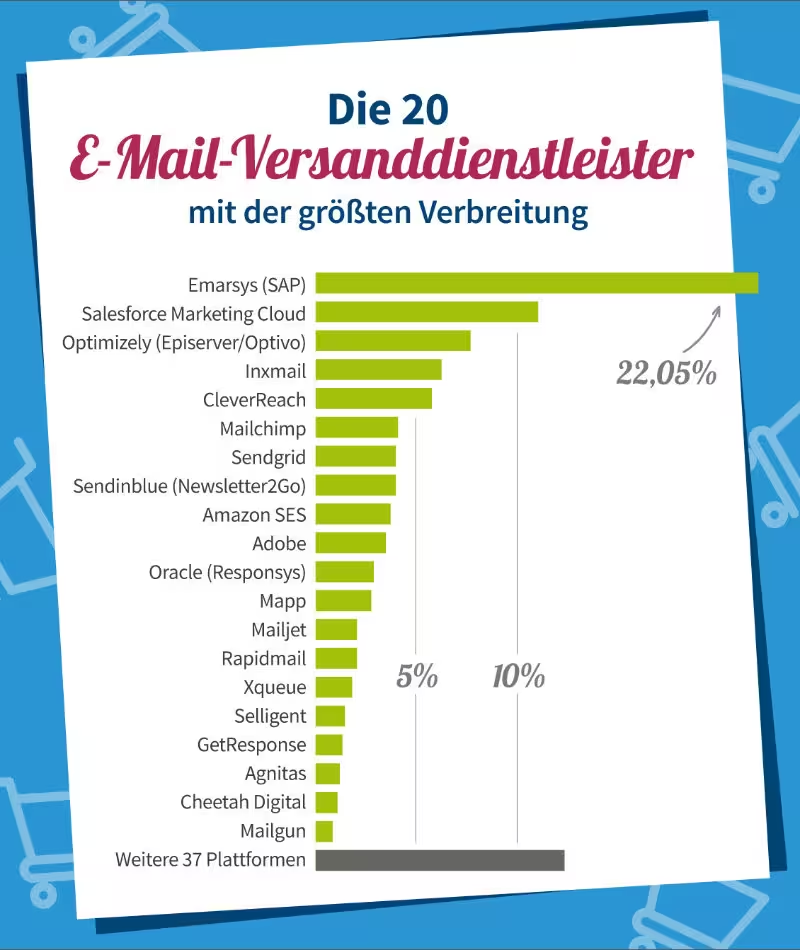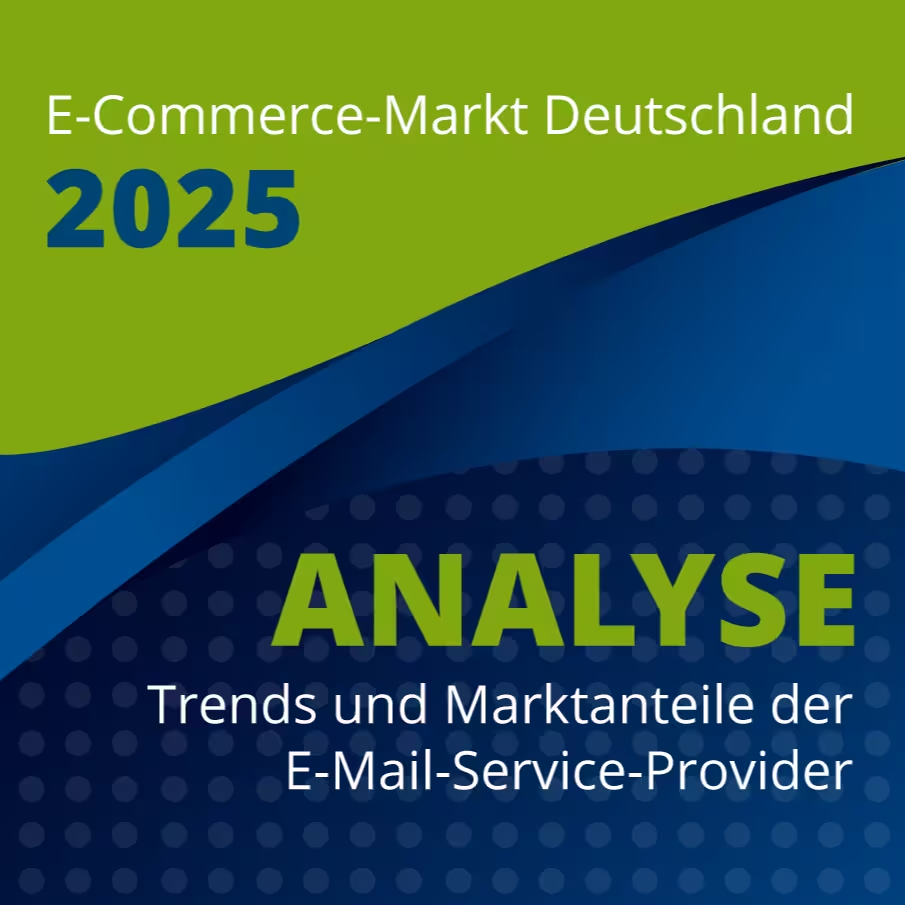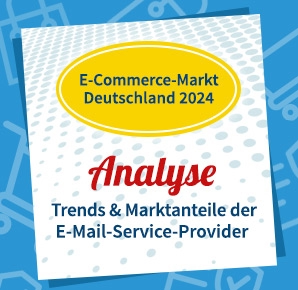Das E-Mail-Marketing der 1.000 umsatzstärksten Onlineshops Deutschlands 2021
87 Prozent der tausend umsatzstärksten Onlineshops in Deutschland betreiben aktiv E-Mail-Marketing1. Welche Tools die Shops dafür einsetzen, haben wir nun bereits zum vierten Mal untersucht im Rahmen der „E-Commerce-Markt Deutschland 2021"-Studie von EHI Retail Institute und Statista. Dazu haben wir erneut bei allen Anbietern Newsletter abonniert, sofern für die Anmeldung kein Kauf vorausgesetzt wurde.
Über 70.000 E-Mails haben wir im Untersuchungszeitraum erhalten. Rund zwei Drittel (68 %) der 871 aktiven Online-Shops hat uns mindestens wöchentlich gemailt, 19 Shops sogar jeden Tag. Nur 129 Unternehmen haben uns nichts geschickt, weil sie entweder keine Newsletter-Anmeldung haben (73) oder diese zwar haben, aber uns außer der Anmeldebestätigung keine E-Mails sendeten (immerhin 56 Firmen). Diese Zahlen sind gegenüber 2020 kaum verändert, was zeigt, dass E-Mail nach wie vor ein äußerst beliebtes Marketing-Instrument ist.
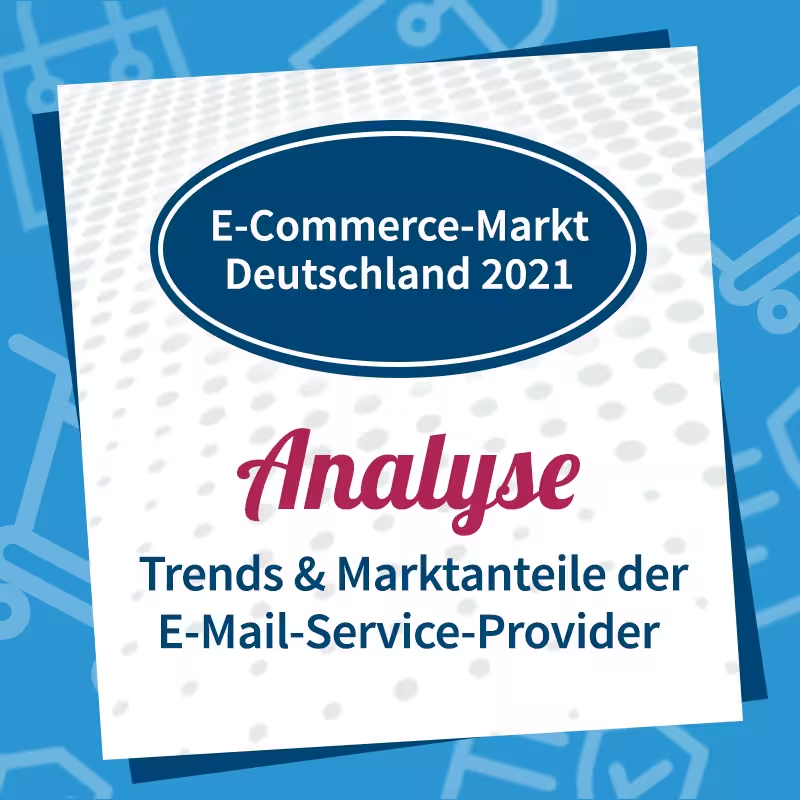
Lesen Sie auch die neusten Ergebnisse der Publicare E-Commerce Studie 2025
Marktanteile der E-Mail-Service-Provider im EHI Top 1.000 E-Commerce
Zur Erkennung der zum Versand genutzten E-Mail-Systeme haben wir die Header der versendeten Newsletter nach Merkmalen durchsucht, die den Versender eindeutig identifizieren. Wo keine professionellen Systeme erkannt werden konnten, sind entweder Eigenentwicklungen im Einsatz oder die im Shopsystem integrierten Versandlösungen. Dies ist allerdings nur selten der Fall: Über 95 Prozent der 871 Shops, die Newsletter versenden, nutzen einen ESP2 (E-Mail-Service-Provider) oder einen Sending Service. 2021 haben wir nicht mehr getrennt zwischen ESPs und „Sending Services", also Lösungen, die durch Schnittstellen (APIs) direkt an den Shop oder andere (Inhouse-) Marketing-Systeme angebunden werden – dadurch tauchen Sendgrid und Amazon SES neu in der Liste auf. Die Grenzen bei der Klassifikation dieser Systeme verschwimmen immer mehr, da manche Sending-Service Anbieter wie z.B. Sendgrid auch beides anbieten, d. h. sowohl ein Marketingautomation-Frontend für Businesskunden als auch ein Sending Service-Backend für E-Mail-Marketing-Anbieter. Lediglich 13 (1,5 %) nutzen dagegen ein Shop-eigenes Script bzw. Modul, bei weiteren 28 (3,2 %) war kein Versandsystem erkennbar. Im Vorjahr war der Anteil dieser beiden Gruppen mit zusammengerechnet 6,2 Prozent deutlich größer. Das zeigt: Immer mehr Onlineshops verlassen sich auf E-Mail-Service-Provider, wenn es um Themen wie Mailserver-Konfiguration, Versandsteuerung oder E-Mail-Zustellbarkeit geht.
Unübersichtlich, fragmentiert und ungleich verteilt
Auch 2021 ist keine Marktkonsolidierung in Sicht: Für ihr E-Mail-Marketing verwenden die Top 1000 umsatzstärksten Online-Shops Deutschlands – genauer: die 830 identifizierten Onlineshops – 64 verschiedene E-Mail-Versandsysteme. Damit zeigt sich erneut das Bild eines hochfragmentierten Marktes, wie wir es schon in den letzten drei Jahren aufgezeigt haben. Immerhin: Erstmals ist die Zahl der Systeme insgesamt gesunken (2020 hatten wir noch 71 ESPs und Sending Services identifiziert, 2019 waren es 70).3
Im Prinzip unverändert ist ebenfalls die ungleiche Verteilung bei den Lösungen: Die 20 meistgenutzten Plattformen haben einen Marktanteil von 87,6 Prozent, die beiden führenden Anbieter Emarsys (in 2020 von SAP übernommen) und Salesforce bedienen allein rund ein Drittel des Marktes. Kein weiterer Anbieter erreicht jedoch die Schwelle von 10 Prozent Marktanteil.
Außerhalb der 20 am meisten verbreiteten Lösungen werden die Nutzerzahlen schnell marginal: Für Bloomreach auf Rang 21, deren Plattform im Januar 2021 aus der Akquisition von Exponea hervorging, konnten wir 7 Shops identifizieren, für Artegic auf Rang 25 waren es 5 Shops – hier führt der Gewinn oder Verlust eines Kunden zu großen Sprüngen, jedoch in einem Bereich mit deutlich unter 1 Prozent Marktanteil.
30 Plattformen werden nur von einem oder zwei der 1.000 umsatzstärksten deutschen Onlineshops verwendet.
Der Markt ist in Bewegung – wenn man lange genug hinsieht
Ein Blick auf die Marktanteile zeigt Emarsys Marketing Platform wie in den Vorjahren als klar meistgenutzte Lösung. 183 der 830 identifizierten Shops (22 %) nutzen die 2020 von SAP erworbene Lösung, fast exakt doppelt so viele wie Salesforce Marketing Cloud (92 Shops, 11 %). Salesforce ist damit bei 9 Shops mehr als 2020 vertreten, einer der größten Zuwächse in unserer Liste – damit setzt der Multi-Cloud-Lösungsanbieter sein Wachstum der letzten Jahre fort (2020: 83 Shops; 2019: 62 Shops; 2018: 41 Shops). Hier zeigt sich: Es ist Bewegung im Markt – eine E-Mail-Service-Plattform wechselt man aber nicht jedes Jahr, sodass sich Trends erst über längere Zeiträume abzeichnen.
Auch der drittplatzierte Optimizely (ehemals Episerver, davor Optivo) setzt einen Trend fort, jedoch in die andere Richtung: Nur noch 64 der Top 1000 Online-Shops nutzen die Lösung – Episerver wurde 2020 noch von 77 E-Commerce-Firmen genutzt, was bereits einer der größten absoluten Verluste gegenüber 2019 bedeutete, als noch 84 Online-Shops auf die Lösung setzten.
Auch Mailchimp verliert recht deutlich und wird nur noch von 40 statt bisher 48 Shops aus unserer Grundgesamtheit genutzt – ob sich hier die Beurteilung des Bayerischen Landesamts für Datenschutzaufsicht auswirkt? Der Marktanteil des US-Unternehmens sinkt jedenfalls langsam, aber stetig, seit wir 2018 zum ersten Mal diese Studie durchgeführt haben, von 6,6 auf jetzt 4,8 Prozent. Eventuell zeigt sich hier, dass Mailchimp in den immer wichtiger werdenden Bereichen Segmentierung und Automationen funktional weniger zu bieten hat als Wettbewerber, bzw. dass viele Funktionen nur im Premium-Paket enthalten sind. Einen ähnlich langsamen, aber stetigen Abwärtstrend sehen wir auch beispielsweise bei Mapp oder Cheetah. Der Marktanteil deutscher E-Mail-Marketing-Plattformen, die ihren Hauptfokus auf den E-Mail-Kanal legen (wie z. B. CleverReach, Inxmail oder XQueue), bleibt mit kleinen Schwankungen relativ stabil.
Ein klarer Gewinner ist dagegen Klaviyo, das mit 10 Shops mehr als 2020 den größten festgestellten Zuwachs überhaupt aufweisen – auch wenn die US-Amerikaner damit insgesamt noch knapp unter 2 Prozent Marktanteil liegen und (noch?) nicht so massiv wachsen wie in ihrem Heimatmarkt. Interessant wird sein, ob auch in Deutschland schlanke Marketing-Automations-Plattformen weiter zulegen wie eben Klaviyo oder GetResponse (von 4 Shops 2020 auf 11 Shops 2021), die zusätzlich zur E-Mail-Automation auch die Erstellung von Landing Pages, Social Advertising oder SMS ermöglichen und schlüsselfertige Integrationen mit vielen Shop-Systemen bieten.
Die Hintergrundversender: Sendgrid, Sparkpost, Amazon SES und Mailgun
Ein Trend, der sich schon in den letzten Jahren abzeichnete, ist der Zuwachs bei den Sending Services: entwicklerorientierte Versandplattformen, die die E-Mail-Zustellung übernehmen – entweder indem sie direkt von der Website/dem Shop per API angesprochen werden oder als Backend-Versandmaschine für einen anderen E-Mail-Service-Provider agieren. Zusätzlich zu den 37 Online-Shops (4,5 %), bei denen wir einen Sending Services identifizieren können, nutzen 32 der Top 1.000 Online-Shops (3,8 %) eine Marketing-Plattform im „Frontend", die im Hintergrund über einen Sending Service versendet. So setzt SAP Marketing Cloud für den Mail-Versand u. a. auf Amazon SES; Braze und Klaviyo versenden E-Mails via Sendgrid; SparkPost wird z. B. von Ometria und Iterable angesprochen und Bloomreach (Exponea) versendet u. a. über Mailgun.3
In unserer Marktanteil-Übersicht oben haben wir jeweils die E-Mail Marketing Provider im „Frontend" aufgeführt, die von den E-Commerce-Unternehmen eingesetzt werden. Aber betrachtet man nur die tatsächlichen E-Mail-Versender, ändert sich die Verteilung: Klaviyo verschwindet wieder aus den Top 20, dafür rückt Mailgun auf. Sendgrid und Sendinblue schieben sich vor auf Platz 7 und 9 der meistgenutzten E-Mail-Versand-Tools im E-Commerce.
In unserer Analyse zu den beliebtesten E-Mail-Marketing-Tools der Top 1.000 US Online Shops 2021 zeigte sich, dass Sendgrid mit knapp 20 % Marktanteil mittlerweile auf Platz 1 der meistgenutzen Versand-Dienstleister im amerikanischen E-Commerce liegt.
Der Trend hat zwei Auswirkungen: Zum einen profitieren die Sending Services von Skaleneffekten – je stärker ein Dienst genutzt wird, desto eher kann er günstige Preise pro versendeter E-Mail (CPM) anbieten. Zudem öffnet sich der Markt weiter: E-Mail Service-Provider, die den Versand über Sending Services abwickeln, können ein Kampagnen-Frontend anbieten, ohne sich um das aufwändige und komplexe Thema Zustellbarkeit zu kümmern. Gerade für Multichannel-Plattformen, für die E-Mail nur einer von vielen Kanälen ist, erfordert dies weniger Investitionen und Know-how.
Ob die Entwicklung bei uns ähnlich wie in den USA verlaufen wird? Vergangenes Jahr lag die Rate der deutschen Shops mit Sending Service bei 3,4 Prozent, dieses Jahr summiert sie sich schon auf 8,3 Prozent. Wir beobachten die Entwicklung weiter.
Die Marktanteile der 64 E-Mail-Service-Provider bei den EHI Top 1.000 E-Commerce-Firmen in Deutschland3
Die komplette Übersicht und 5 Jahres-Trend der Marktanteile der genutzten E-Mail-Marketing-Versandlösungen im deutschen E-Commerce 2021, teilen wir gerne auf Anfrage mit Ihnen. Wir führen diese Studie jedes Jahr durch, lesen Sie daher auch unsere neuste Studie für eine aktuelle Marktübersicht der aktuellen Marktanteile. Wenn Sie an weiteren Informationen über die Daten von 2021 interessiert sind, empfehlen wir Ihnen die ausführliche Studie von EHI/Statista.
Methode und Grundgesamtheit
1 Basis: Die 1.000 umsatzstärksten B2C-Onlineshops und ausgewählte Marktplätze 2021, ermittelt von EHI Retail Institute „E-Commerce-Markt Deutschland 2021", sortiert nach E-Commerce-Umsätzen im Geschäftsjahr 2020.
2 Onlineshops, die im Untersuchungszeitraum von 12 Monaten mindestens eine Marketing-E-Mail gesendet haben in Prozent. n = 871.
3 Onlineshops, die im Untersuchungszeitraum von 12 Monaten E-Mails über eine als ESP oder Sending Service identifizierte Versandplattform gesendet haben. Der prozentuale Marktanteil errechnet sich aus der Anzahl der Firmen, bei denen der jeweilige Versender identifizierbar war. n = 830.
* ohne Firmen, die diesen Sending Service als Backend-Versender einer Marketingautomation nutzen – in diesem Fall wurde das „Front-End"-Tool in dieser Liste aufgeführt (falls der jeweilige ESP identifizierbar war.).


